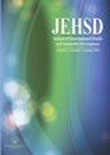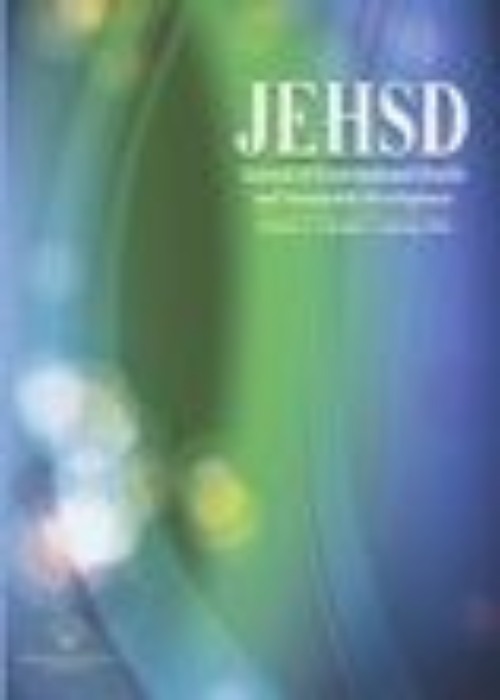فهرست مطالب

Journal of Environmental Health and Sustainable Development
Volume:3 Issue: 2, Jun 2018
- تاریخ انتشار: 1397/04/03
- تعداد عناوین: 8
-
Pages 488-491
-
Pages 496-503IntroductionExposure to high concentrations of fluoride in drinking water can negatively affect lung, liver and kidney tissues, and cause skeleton pain; however, lack of fluoride can cause tooth decay and bone problems.Materials And MethodsIn this study, the concentration of fluoride was investigated and its spatial distribution was carried out with Arc GIS software in underground water of Abarkouh aquifer. The health risk assessment, type of pollution distribution and its source was investigated using Moran's index.ResultsThe average concentration of fluoride in 21 wells was 0.623 ± 0.296 mg/L which in 47.61% were less than the minimum concentration standard range set by the WHO guidelines. The Moran's index for fluoride concentration in the study area was 0.653 and given the z-score of 4.117. There is less than 1% likelihood that this clustered pattern could be the result of a random chance.ConclusionAccording to the results, Non-carcinogenic risk indicates a high risk for children (HQ = 1.03E0). The source of pollution is close to well No. 15. Investigating the study area and eliminating the pollution source is effective in decreasing the fluoride concentration of water and can reduce the health risk for children.Keywords: Fluorides, Geographic Information System, Risk Assessment, Drinking Water
-
Pages 504-508IntroductionMilk is one of the most complete food products that is effective in reducing blood pressure and increasing its beneficial fats, preventing colon cancer and osteoporosis, and providing many nutrients, such as protein and calcium. Therefore, the contamination of this valuable foodstuff and its products is considered as a serious risk to the public health of the community. Aflatoxin is a dangerous fungal toxin that is produced in the presence of moisture and heat as well as lack of proper storage conditions; moreover, it is considered as a hazardous substance in human health. The aim of this study was to evaluate the level of Aflatoxin M1 (AFM1) in raw milk, pasteurized and sterilized milk in food distribution centers of Hamadan province in 2016.Materials And MethodsIn the present study, 586 traditional and pasteurized milk samples (446 pasteurized milk samples and 140 traditional milk samples) produced in Hamadan province in summer of 2016 were investigated for AFM1 using Quick AFM1 Strip Test Code ASTM1/96 kit.ResultsAFM1 was not observed in 2% of traditional samples and 6.7% of pasteurized specimens. In this study, 37.85% of traditional milk, 56.3% of pasteurized samples had AFM1 less than 50 ppt. Moreover, 12.5% of traditional milk and 1.5% of pasteurized samples had AFM1 more than 50 ppt, which was higher than Iran standard limitation.ConclusionThe results of this study indicate the presence of AFM1 toxin contamination in traditional and pasteurized milks of Hamedan province. Further investigation and monitoring is needed in Hamedan province.Keywords: Aflatoxin M1, Hamadan City, Pasteurized Milk, Traditional Milk
-
Pages 509-517IntroductionExtended aeration activated sludge system has a lower sludge production than other activated sludge processes. Due to its high hydraulic retention time (HRT), the tolerance of this process is higher than the shocks caused by increased organic loading rate. The main objective of this study is to evaluate the performance of the aeration system in removing physicochemical and microbial parameters from the wastewater of Nowshahr, Iran.Materials And MethodsThis is a descriptive-analytical study that was carried out in the wastewater treatment plant of Nowshahr during 6 months. The parameters BOD5, COD, TSS, total coliform (TC) and fical coliform (FC) were measured, and also the MLSS, F/M ratio, SVI, HRT and θc were measured in aeration basin. Data were analyzed using the Excel software and SPSS (Pearson correlation test and one-sample t-test), and PResultsThe average removal efficiency of BOD5, COD, TSS, TC and FC was 57.7%, 61.4%, 70.8%, 84.6% and 84.3% respectively. The θc, HRT, SVI, F/M and MLSS in the aeration basin were obtained, respectively, 5.64 day, 25 h, 48.83 ml/g, 0.28 day-1 and 180 mg/L. In addition, the average output of parameters in the hot months of the year was higher than those in the cold months.ConclusionAccording to the results, the Nowshahr wastewater treatment plant has the adequate efficiency to produce effluent in accordance with environmental standards for discharge into surface water and consumption in agriculture.Keywords: Activated Sludge, Extended Aeration, Wastewater Treatment, Nowshahr City
-
Pages 518-530IntroductionDue to the rapid development of technology and growth of economic activities in recent years, the use of electrical and electronic devices has increased dramatically, which is contributed to the proliferation of waste generated by these e-waste (Electric and Electronic waste) products.Materials And MethodsIn this study, the status of e-waste in Dezful city in 2017 was studied. Accordingly, the types and amount of e-waste in residential and commercial-administrative areas were identified, and it was found that the amount of e-waste produced in these areas was totally about 1291 tons and the annual per capita of each family in residential areas was 15 ± 0.5 and for each unit in administrative-commercial areas was 180 ± 5. Then, with the breakdown and identification of their valuable components (gold, silver, copper, etc.) the financial value of each gram of these components was also calculated and the obtained information was entered to Excel software.ResultsBy using the MATLAB software, the benefits of retrieving valuable components extracted from e-waste in residential and administrative-commercial areas, as well as the costs of recycling and collecting e-waste were calculated individually. Eventually, the annual benefits of recycling and collecting e-waste in Dezful were $ 1091338 and their annual costs were $ 615,556, resulting in NPV (Net Present Value) calculated $ 475,782 annually.ConclusionTherefore, based on the cost-benefit model (CBA), it was shown that the NPV is positive, which indicates that e-waste recycling and collection is economically feasible.Keywords: Waste Recycling, Electronic Wastes, Cost-Benefit Analysis, Dezful City
-
Pages 531-538IntroductionPaper and paperboard industry wastewater has potentially damaging effects on the ecosystem of the receiving environments due to the presence of toxic compounds. As a result, the treatment of such wastewater is necessary prior to discharge into the environment. In this study, the potential of Plantago major L. seed extract as a natural coagulant in treating paper and paperboard industry wastewater was investigated.Materials And MethodsIn this experimental study that was carried out in vitro, the effects of the pH (5, 6, 7, 8, 9, 10 and 11) of the solution and different doses (0.05, 0.1, 0.15, 0.2 and 0.25 g/L) of coagulant were studied. At each step of optimization turbidity, TSS and COD were measured according to the methods presented in the books on water and wastewater testing standards.ResultsOptimal pH for removal of turbidity, TSS and COD using Plantago major L. seed extract was determined 10, with the removal efficiency of 60%, 76% and 36%, respectively. The optimal dose of coagulant was obtained 0.1 g/L, with the maximum efficiency of 80%, 87% and 37.7% for turbidity, TSS and COD, respectively.ConclusionBased on the results of this study, Plantago major L. seed extract can be used as a natural coagulant without causing environmental risks.Keywords: Plantago major L. seed, Wastewater Treatment, Paper, Paperboard Industry, Natural Coagulant
-
Pages 539-552IntroductionStudying the changes in surface water storage and exchanges with groundwater in the hydrological system of rivers is a prerequisite for water resources management in the basin. In this paper, Zayandehrood River has been studied and the historical series of flow has been used in six hydrographic stations located downstream the Zayandehrood Dam.Materials And MethodsBased on the surface water balance and considering monthly inflows and outflows in each river reach, a general equation for water outflow was extracted for each month, in which the net interaction of surface water with the water in the air and groundwater are in the form of a polynomial of the inflows and a constant.ResultsThe obtained equations showed that in two reaches, surface water was increased by groundwater and in the other three reaches, surface water fed the groundwater. The results showed that in normal conditions, 1613 million cubic meters of surface water resources were consumed in the reaches under study. In the event of severe drought, except for the first three reaches (from the sadtanzimi to Lenj), the remaining reaches (downstream Lenj) faced water shortage. The results showed that increasing surface water by groundwater is very important for water supply in drought condition.ConclusionBased on the results, the proposed method is an appropriate tool for investigating the exchange of surface water with groundwater.Keywords: Surface Water, Groundwater Exchange, River Flow, Mass Balance, River Reach


